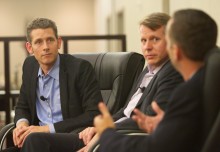Have you ever been so engrossed in an activity that you completely lost track of time? Perhaps you’ve experienced a runner’s high, where each strides feels effortless?

If so, then you have experienced ‘flow’ – a concept pioneered by Mihaly Czikszentmihalyi that refers to an activity that “draws one in with its complexity to such an extent that one becomes completely involved in it.”
Mihaly’s research shows that the ways in which people describe activities they deeply enjoy are remarkably common, despite the fact that the activities they’re actually doing are quite different. This demonstrates that flow is more about the mental state than the activity itself.
I was first introduced to flow by our team’s psychologist while playing golf for Purdue University. Flow in sports is synonymous with peak performance; we were taught how to develop a frame of mind that would make flow more likely to happen. The goal was to stay in the present moment by being so intently focused on the pre-shot routine that the pressure of competition had no room to negatively impact performance.
Notice the similarity in a surgeon’s account of why his job is so enjoyable:
“In good surgery everything you do is essential, every move is excellent and necessary; there is elegance, little blood loss, and a minimum of trauma…This is very pleasant, particularly when the group works together in a smooth and efficient manner.”
While it’s true that flow is most commonly associated with athletic and artistic pursuits, Mihaly’s book “Good Business” lays out a framework for cultivating flow in business, and it’s all about shaping the culture and environment appropriately to increase the likelihood of flow occurring in the workplace. It’s a powerful antidote to the current state of employee dissatisfaction that persists in many work environments.
We’ve all seen the stats – this study surveyed 30,000 employees across the globe and found that between 28% and 56% of employees expressed a desire to leave their job. The rate was 32% in the U.S.
That’s staggering.
Nearly 1 in 3 employees in the U.S. is so dissatisfied with their job that they want to leave. As leaders and managers, we’ve got to do something about this if we want to attract and retain the best workforce. I believe the insights from flow research have the power to radically transform the culture of businesses from every corner of the globe and restore a sense of meaning and purpose to the janitor’s closet all the way to the corner office.
As in almost every pursuit, it all starts with vision. Mihaly believes that “if an enterprise does not aspire to be the best of its kind, it will attract second-rate employees, and it will be soon forgotten.” Yvon Chouinard, founder of Patagonia, participated in flow research and Mihaly describes their encounter at Patagonia’s headquarters:
“I complemented Chouinard on how handsome an environment he had managed to carve out of an abandoned industrial building that was almost a century old. “Yeah,” Chouinard answered, “you don’t build something like this if you’re going to go public in three years and cash out and walk away. So we really do try to act like this company is going to be here a hundred years from now.”
What would be different about your decision-making if you had a 100-year vision for your company? I encourage you to imagine the impact in your own life if you could truly say that you find deep enjoyment and satisfaction in your job. Then imagine the impact on your staff and the culture of your company. Life is too short to go through the motions at work.
Over the next couple of weeks, we’re going to delve deeper into flow theory and discuss why flow doesn’t happen on the job and what you can do to cultivate flow in your company culture. This is a leadership imperative for the 21st century.
photo credit: “Flow” Chart via Joshuaspodek.com


